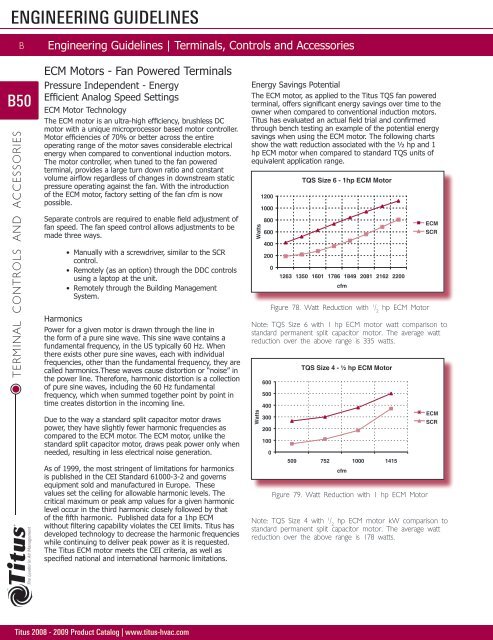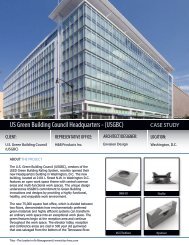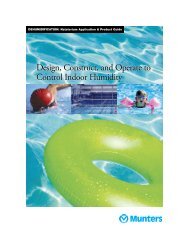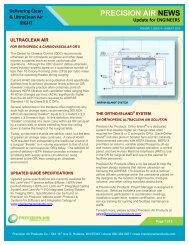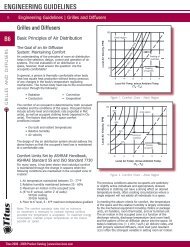Titus 2008 - 2009 Product Catalog | www.titus ... - Texas Air Products
Titus 2008 - 2009 Product Catalog | www.titus ... - Texas Air Products
Titus 2008 - 2009 Product Catalog | www.titus ... - Texas Air Products
Create successful ePaper yourself
Turn your PDF publications into a flip-book with our unique Google optimized e-Paper software.
ENGINEERING GUIDELINES<br />
B<br />
B50<br />
TERMINAL CONTROLS AND ACCESSORIES<br />
Engineering Guidelines | Terminals, Controls and Accessories<br />
ECM Motors - Fan Powered Terminals<br />
Pressure Independent - Energy<br />
Efficient Analog Speed Settings<br />
ECM Motor Technology<br />
The ECM motor is an ultra-high efficiency, brushless DC<br />
motor with a unique microprocessor based motor controller.<br />
Motor efficiencies of 70% or better across the entire<br />
operating range of the motor saves considerable electrical<br />
energy when compared to conventional induction motors.<br />
The motor controller, when tuned to the fan powered<br />
terminal, provides a large turn down ratio and constant<br />
volume airflow regardless of changes in downstream static<br />
pressure operating against the fan. With the introduction<br />
of the ECM motor, factory setting of the fan cfm is now<br />
possible.<br />
Separate controls are required to enable field adjustment of<br />
fan speed. The fan speed control allows adjustments to be<br />
made three ways.<br />
• Manually with a screwdriver, similar to the SCR<br />
control.<br />
• Remotely (as an option) through the DDC controls<br />
using a laptop at the unit.<br />
• Remotely through the Building Management<br />
System.<br />
Harmonics<br />
Power for a given motor is drawn through the line in<br />
the form of a pure sine wave. This sine wave contains a<br />
fundamental frequency, in the US typically 60 Hz. When<br />
there exists other pure sine waves, each with individual<br />
frequencies, other than the fundamental frequency, they are<br />
called harmonics.These waves cause distortion or “noise” in<br />
the power line. Therefore, harmonic distortion is a collection<br />
of pure sine waves, including the 60 Hz fundamental<br />
frequency, which when summed together point by point in<br />
time creates distortion in the incoming line.<br />
Due to the way a standard split capacitor motor draws<br />
power, they have slightly fewer harmonic frequencies as<br />
compared to the ECM motor. The ECM motor, unlike the<br />
standard split capacitor motor, draws peak power only when<br />
needed, resulting in less electrical noise generation.<br />
As of 1999, the most stringent of limitations for harmonics<br />
is published in the CEI Standard 61000-3-2 and governs<br />
equipment sold and manufactured in Europe. These<br />
values set the ceiling for allowable harmonic levels. The<br />
critical maximum or peak amp values for a given harmonic<br />
level occur in the third harmonic closely followed by that<br />
of the fifth harmonic. Published data for a 1hp ECM<br />
without filtering capability violates the CEI limits. <strong>Titus</strong> has<br />
developed technology to decrease the harmonic frequencies<br />
while continuing to deliver peak power as it is requested.<br />
The <strong>Titus</strong> ECM motor meets the CEI criteria, as well as<br />
specified national and international harmonic limitations.<br />
<strong>Titus</strong> <strong>2008</strong> - <strong>2009</strong> <strong>Product</strong> <strong>Catalog</strong> | <strong>www</strong>.<strong>titus</strong>-hvac.com<br />
Energy Savings Potential<br />
The ECM motor, as applied to the <strong>Titus</strong> TQS fan powered<br />
terminal, offers significant energy savings over time to the<br />
owner when compared to conventional induction motors.<br />
<strong>Titus</strong> has evaluated an actual field trial and confirmed<br />
through bench testing an example of the potential energy<br />
savings when using the ECM motor. The following charts<br />
show the watt reduction associated with the ½ hp and 1<br />
hp ECM motor when compared to standard TQS units of<br />
equivalent application range.<br />
Watts<br />
Figure 78. Watt Reduction with 1 / 2 hp ECM Motor<br />
Note: TQS Size 6 with 1 hp ECM motor watt comparison to<br />
standard permanent split capacitor motor. The average watt<br />
reduction over the above range is 335 watts.<br />
Watts<br />
1200<br />
1000<br />
800<br />
600<br />
400<br />
200<br />
600<br />
500<br />
400<br />
300<br />
200<br />
100<br />
0<br />
0<br />
TQS Size 6 - 1hp ECM Motor<br />
1263 1350 1601 1786 1849 2081 2162 2200<br />
cfm<br />
TQS Size 4 - ½ hp ECM Motor<br />
509 752 1000 1415<br />
cfm<br />
Figure 79. Watt Reduction with 1 hp ECM Motor<br />
ECM<br />
SCR<br />
ECM<br />
SCR<br />
Note: TQS Size 4 with 1 / 2 hp ECM motor kW comparison to<br />
standard permanent split capacitor motor. The average watt<br />
reduction over the above range is 178 watts.


